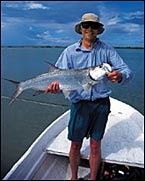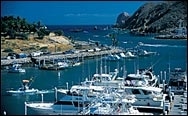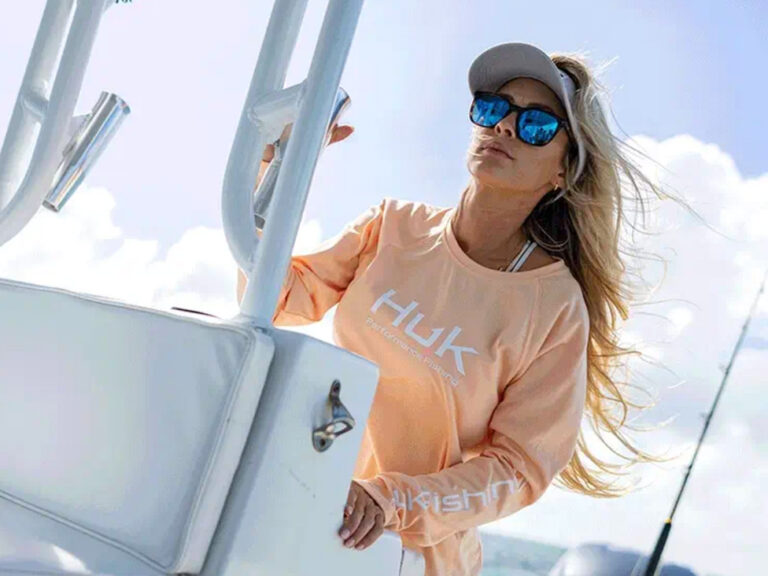
From Baja to the Yucatan, Mexico offers a dizzying array of game fish, destinations and accommodations to choose from. In fact, deciding what to fish for and where to stay may be the hardest parts of planning a trip to this remarkably diverse country! Whether you want to trailer your own boat, fly in to a full-scale luxury resort, cast from a panga or troll from a tricked-out cruiser, Mexico’s got you covered. Furthermore, fishing in Mexico is easier than ever, thanks to an abundance of hotels and lodges, first-rate charter fleets, state-of-the-art marinas, improved highways and launch ramps. Here’s a brief overview of what you can expect.
East Coast

The white-sand bottoms of the eastern Yucatan’s shallow bays make for excellent sight-casting to tarpon, bonefish, snook and permit.|
Less than two hours’ flying time from much of the southeastern U.S., Mexico’s Yucatan Peninsula offers some of the finest and most exciting fishing in the hemisphere. The hit parade includes tarpon, snook, bonefish, permit, sailfish, marlin, and many other species. Thirty years ago there were only two or three camps that offered inshore fishing, and the only spot for blue-water action was Cozumel. Today, facilities for both pursuits are numerous, with more being added almost every year.
Inshore
Most of the fishing for bonefish, tarpon, permit and snook takes place in two areas: Espiritu Santo and Ascension Bays just north of the Belizian border, and in the series of small bays that dot the coast from Cancun north to Isla Holbox. There are a number of quality camps and charter operations in all of these places, with seaworthy boats, competent guides, good food and comfortable lodging.
Espiritu Santo Bay is located just north of Chetumal Bay. This shallow bay features a series of small lagoons with white sand bottoms that offer truly spectacular sight-fishing. They are well stocked with bonefish, small to medium tarpon, permit, and snook. Often all four species can be found in the same lagoon. In addition, the many small to medium-sized brackish “lakes” starting south of Espiritu Santo offer good fishing for tarpon and snook. The fishing in this region remains good all year, but really shines from May through November.

For large permit, Ascension Bay can’t be beat with wily fish that occasionally best the 40-pound mark.|
Ascension Bay, located 15 miles north of Espiritu Santo, comprises extensive flats and many small bays and coves that are protected from the wind. Ascension is noted for its large permit that sometimes top 40 pounds, and for its periodic winter runs of tarpon. Throughout the bay, numerous flats and lagoons offer excellent bonefishing.
Another four miles north of Ascension Bay is a camp called Pesca Maya, and six miles north of that is Boca Paila. An extensive series of interconnected small, sandy bays full of bonefish, permit, snook and small tarpon extends from north of Boca Paila all the way south to Ascension.
Farther up the coast, just north of Cancun, is a series of small bays near Isla Blanca that also offer tarpon, bonefish, snook and permit. Anglers stay in the Cancun area and make daily trips in a guided skiff.
Just west of the northeast corner of the Yucatan peninsula is Isla Holbox, which has recently been discovered to offer excellent tarpon fishing. While there is not yet an established fishing camp at Holbox, anglers can fish the area from Cancun.
Offshore
The first destination on the Yucatan to offer offshore fishing for billfish, tuna, wahoo, dorado and others was Cozumel. Pioneered by several U.S. charter skippers in the early 1970s, this area boasts some of the most spectacular fishing for Atlantic sailfish to be found anywhere. These exciting fish first appear on their northward migration in March, and pour through the channel that separates Cozumel from the mainland in great numbers until late June. Joining the sails are white marlin, blue marlin, swordfish, yellowfin tuna and sometimes even a few giant bluefin tuna.
Today you can also find fleets of quality charter boats out of Cancun, Isla Mujeres (an island near Cancun) and the new resort of Puerto Aventuras, located an hour’s drive south of Cancun.
Offshore charters range from $150 for a half day in 22- to 25-foot open panga to $1,000 per day for the largest boats. The average is around $500 to $750 per day for 27- to 40-foot boats.
Fly fishing for Atlantic sailfish was already coming on strong by the 1980s and is red hot today. In fact, the Yucatan has become a mecca for all types of light-tackle billfishing, made possible by the many experienced captains and crews.
The offshore and reef fishing season extends throughout the year, with the peak period for the blue water species from April through July.
Western Baja

While some are full-blown resorts and others traditional fishing villages, many ports throughout Mexico offer charter fleets within easy reach of great fishing.|
Development is booming in the northwest corner of Baja. Only a short drive south of San Diego, Ensenada’s new resort and marina are attracting an increasing number of fishermen. During summer and fall, a varying mix of albacore, bluefin tuna, yellowfin tuna, striped marlin, dorado and yellowtail can be found here within 20 miles of shore. The nearby Todos Santos Islands offer exceptional fishing for bigger yellowtail, while the kelp-fringed reefs hold calico bass, bonito, barracuda, halibut and more. Party boats, charter boats and a steady supply of live bait are all available in Ensenada Harbor.
Though quaint by resort standards, San Quintin, 120 miles south of Ensenada, has continued to expand its fisherman-friendly services with additional lodging and several charter fleets. Both pangas and cruisers are available for making the nine-mile run to the mouth of the bay or the additional eight-mile trek offshore to San Martin Island, a prime spot for big yellowtail and calico bass. Beyond the island, tuna, striped marlin and dorado are available in summer and fall.
Continuing south, the wild western shore of Baja offers little or no boating facilities until you come to Los Cabos, as the sister towns of Cabo San Lucas and San Jose del Cabo are collectively referred to. A world-class resort area with a large collection of hotels and a modern marina, Los Cabos reigns as the Marlin Mecca of Mexico. The area has accounted for numerous world records, and some 50,000 marlin (blue, striped and black) and sailfish are caught here each year (most billfish are now released). Also available in the surrounding waters are yellowfin tuna, dorado, wahoo, cabrilla and roosterfish. There are numerous fishing fleets and accommodations to choose from, ranging from the affordable to ultra-luxurious.
The Cortes

The hard-fighting and exotic roosterfish is reason enough to visit many destinations along the Sea of Cortes.|
Los Cabos serves as the gateway to the Sea of Cortes, often called “the world’s largest fish trap.” An optimum combination of currents, water temperatures and geography make this one of the fishiest bodies of water in the world. Just a short drive northeast of Los Cabos is the famous fishing area known as the East Cape, home to an enclave of diverse beach hotels, each with its own fleet of pangas and cruisers. All three marlin species, plus sailfish, yellowfin tuna, wahoo, dorado, yellowtail and amberjack frequent the offshore waters. You can also enjoy action with grouper, cabrilla and snappers around the nearshore reefs, or tangle with roosterfish along the beaches.
A little farther north, the city of La Paz offers access to some of the finest fishing in the Cortes. Local action is often concentrated around Espiritu Santo Island or El Bajo Bank. Many of the same species encountered off the East Cape are available off La Paz, though on a more seasonal basis. Marlin and sailfish are present from spring through fall; dorado and tuna are available year-round; cabrilla, pargo and grouper peak in early spring; yellowtail in winter and spring, and roosterfish in spring and fall. A bit to the south, the waters off Las Arenas and Muertos Bay offer all the above species, plus sensational rooster fishing and a bonus catch of big groupers. In summer, wahoo and amberjack join in on the offshore action.
Blue-water game fish migrate deep into the Cortes each summer, drawing anglers to a series of resort communities that include, from south to north, Loreto, Mulege, Punta Chivato and Santa Rosalia. The region’s chiseled coastline and nearshore islands provide exceptional habitat for grouper, cabrilla and snapper, while the sandy beaches are home to roosterfish in spring and fall. Yellowtail fishing can be phenomenal around the islands in spring, and massive schools of dorado arrive in summer. This is also when boaters venturing beyond the islands can encounter incredible action with tuna, sailfish and marlin. Improved launch ramps and campgrounds make this a prime area for trailer-boaters; but fine hotels and quality panga fleets are also available.
In the upper reaches of the Cortes, the Midriff Islands serve as the primary fishing grounds, both for trailer-boaters launching from the remote Bay of Los Angeles and panga fishermen headquartered on special motherships that typically launch from the town of San Felipe. Dorado, tuna and marlin can be plentiful in summer, but the spring white seabass bite and intense summer action with yellowtail, grouper and cabrilla is what makes this region popular.
The Mainland

For anglers who like to travel in style, coastal resorts – such as El Cid Resort in Mazatlan – provide comfortable quarters and great food.|
Jumping to the mainland, the first major city you come to is Mazatlan, a famous destination for sailfish, but which also boasts some of the world’s best daytime swordfishing. Although Mazatlan is a sizable city, it offers a friendly atmosphere. Available are numerous fleets of charter boats at affordable rates – around $250 for a full-day charter with equipment and guides. Striped marlin, dorado, grouper and various species of jacks are available year-round. For sailfish, blue and black marlin, as well as yellowfin tuna and roosterfish, the best months are March through December.
Though Puerto Vallarta has a massive, first-class marina, this fabled city has never aggressively promoted itself as a world-class fishing destination. While protecting the city from tropical storms, giant Banderas Bay dictates a long run of 30 miles or more to reach blue water. However, sailfish and small tunas are seasonally available inside the bay, with October through February being the best months for wahoo, dorado and roosterfish.
For a fishing destination that’s off the beaten track, look no further than the quaint village of Barra de Navidad. Located just 20 miles north of Manzanillo, this sleepy little town is home to a surprising number of comfortable hotels and a modern 21-boat charter fleet that includes more than a dozen super-pangas and seven cruisers ranging from 23 to 60 feet, all equipped with GPS, radios and top-notch fishing equipment. Sailfish and blue marlin are available year-round, with dorado showing from mid-November through March. Yellowfin tuna, wahoo and striped marlin can be caught in summer.
Located even farther south, midway between Manzanillo and Acapulco, is Zihuatanejo, a true Mexican fishing village. Close by is the luxury beach resort of Ixtapa, which boasts a first-class marina and charter fleet. The Zihuatanejo/Ixtapa area sees an enormous number of sailfish from November through June, and also hosts a fantastic winter fishery for marlin, tuna, dorado, roosterfish, jacks and more.
Finally, there’s Huatulco, a “secret spot” generally undiscovered by the angling masses. It’s just about as far south as you can get, but the fishing for billfish and other blue water gamesters can be sensational. Huatulco is for high-rollers only, and an overnight run for swordfish costs $900 per day.









